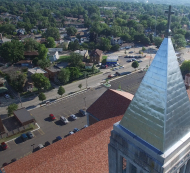Summer Travels, Part 1: Kentucky
Twice a year, all the bishops across the U.S. gather for meetings held by the United States Conference of Catholic Bishops (USCCB). A few weeks ago, we met in Louisville, Kentucky. One of the committees I serve on made an unconventional decision to hold our half-day of meetings not in the hotel, but at the proto-cathedral in Bardstown, Kentucky.
What is a proto-cathedral, you might wonder? Generally, a proto-cathedral is a church that functions as the temporary cathedral of a diocese until a more suitable cathedral can be built or until the existing cathedral can be repaired or renovated. Bardstown’s cathedral was designated a proto-cathedral because it is the first or original cathedral, completed and opened in 1819, in what is now the Archdiocese of Louisville.
So, ten bishops, plus USCCB staff members, climbed into a van and drove past horse farms and distilleries for about 30 minutes until we arrived at the Basilica of Saint Joseph Proto-Cathedral in Bardstown, Kentucky. When we arrived, the exterior and façade immediately reminded me fondly of the Chapel at Mundelein Seminary with its use of red brick and stone in the Early American tradition. We were promptly treated to great Kentucky hospitality with a lunch that included homemade pot roast with potatoes, carrots, celery, and rice krispie treats for dessert (yes, I have a sweet tooth!).
We conducted our normal course of business which was enlivened by a tour of the Cathedral guided by the Rector. He began with an interesting history lesson. The Diocese of Bardstown, Kentucky, was established on April 8, 1808, along with the Dioceses of Boston, New York, and Philadelphia. As one of the earliest dioceses in the United States, it was created to serve the growing Catholic Church population, particularly west of the Appalachian Mountains. The territory included most of Kentucky, Tennessee, Missouri, Illinois, Indiana, Ohio, and Michigan. (To keep things in perspective, here in the Diocese of Joliet we are celebrating our 75th Jubilee while the Diocese of Bardstown was established some 216 years ago; such a rich history!).
To build the church, bricks were baked nearby, and poplar trees were positioned in a circular pattern to form the majestic columns inside and out. The foundation was built with limestone, which is so solid that the walls have never cracked. Exquisite religious paintings adorn the interior space, donated mostly by European royalty.
People had originally arrived in the Kentucky area by horse and wagon, so the diocese was established inland. However, with the popularity of the steamboat, the city of Louisville swiftly grew alongside the banks of the Ohio River. With this population shift, in 1841 the Diocese of Bardstown was transferred to Louisville, and St. Louis Church, now the Cathedral of the Assumption, became the new cathedral. The Diocese of Louisville was then elevated to an archdiocese in 1939. Even with all these changes, the proto-cathedral of Bardstown still functions as a Catholic parish church.
How delightful it was to travel and learn something new about the history of the Church in the USA. It also caused me to reflect on the fact that change in the Catholic Church is not something new. As you know, we in the Diocese of Joliet are in our third and final phase of targeted restructuring. It struck me that the Catholic Church has always had to respond to and even adjust to new demographics and shifting realities. When they laid that magnificent cornerstone in Bardstown in July 1816, I am sure no one was predicting that one day their very diocese would be relocated to Louisville. Like them, we continue to trust in the Holy Spirit and adapt to the changing times to embrace a Church that is always on the move and yet still beautifully thriving.
As I shift gears and travel to Indianapolis later this month for the National Eucharistic Congress, I look forward to sharing my experience and reflections in next month’s “Summer Travels, Part II: Indianapolis” article. Until then, enjoy the summer, be safe, and may God bless you along the journey.




